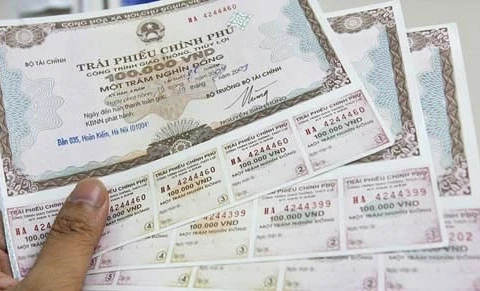
Hanoi (VNA) – At the end of November, the size of the Government bond (G-bond) market was equal to 25.1 percent of the gross domestic product (GDP) of 2019, rising 12-fold from 2009, data show.
The figure was revealed by Phan Thi Thu Hien, Director of the Department of Banking and Financial Institutions under the Ministry of Finance, during a conference in Hanoi on December 10 that reviewed the 10-year operation and development of the G-bond market.
The market was officially opened in 2009. So far, both the size and liquidity of this market have increased, giving it a crucial role to play to develop the capital market and bond market of Vietnam.
In the first 11 months of this year, the market’s liquidity reached 9,000 trillion VND each trading session, soaring 24 times from 2009, the ministry reported.
The Vietnamese G-bond market has grown at an average rate of 27 percent per year over the past decade, the fastest pace among emerging economies in East Asia, Hien said.
She noted the G-bond market has become an effective channel for mobilising medium and long-term capital for the State budget. The focus on issuing long-term G-bonds has enabled the Government to increase domestic borrowing and reduce foreign loans.
From 2009 to 2019, thanks to G-bond issuance, 1.96 quadrillion VND was mobilised for the State budget, an average of about 175 trillion VND per year.
 The conference in Hanoi on December 10 reviews the 10-year operation and development of the G-bond market (Photo: VietnamPlus)
The conference in Hanoi on December 10 reviews the 10-year operation and development of the G-bond market (Photo: VietnamPlus) Also in this period, 385.15 trillion VND was raised via Government-guaranteed bonds and another 36.92 trillion VND via municipal bonds, respectively equivalent to more than 35 trillion VND and 4.61 trillion VND each year on average.
In recent years, the G-bond channel has made up 75 – 80 percent of the total capital mobilised annually, according to Hien.
Regarding the development plan for 2021 – 2025, the official said the goal for the next five years is to meet the demand to raise capital for socio-economic development as official development assistance (ODA) and preferential loans decrease.
The Government gives priority to optimising internal strength, keeping macro-economic stability and developing sustainably at the same time with accelerating economic growth.
To this end, Vietnam will press on with implementing the road map for developing the bond market in the 2017 – 2020 period, with a vision to 2030, that was approved by the Prime Minister on August 14, 2017.
In particular, for the primary market, the Government needs to connect capital mobilisation via G-bonds with budgetary governance and fund management. For the secondary market, efforts will be made to increase the trading volume of G-bonds, Government-guaranteed bonds and municipal bonds to 1 percent of the listed outstanding bond value in 2020 and to 2 percent by 2030, she noted.
At the same time, she said, market organisation and trading will be improved, shortening the process from issuance to registration, deposit, listing, trading and payment in accordance with the development of Fourth Industrial Revolution to increase liquidity in the secondary market.
Vietnam’s G-bond market will become a safe, effective and highly lucrative investment mechanism for commercial banks, insurance networks, investment funds and foreign investors, Hien stated.
At the conference, Alwaleed Alatabani, Lead Financial Sector Specialist at the World Bank in Vietnam, said that in recent years, the G-bond market has achieved remarkable results. The World Bank highly appreciates the close cooperation of Vietnamese State agencies in the development of the country’s G-bond market.
He recommended that, as the market is growing, it is necessary to expand the network of investors holding G-bonds in order to gradually reduce the dependence on investors from the banking sector.
There is a need for a broader and more diverse legal framework to encourage non-banking investors, including those from insurance, investment funds and foreign investors, to participate in the G-bond market, Alatabani added./.
























